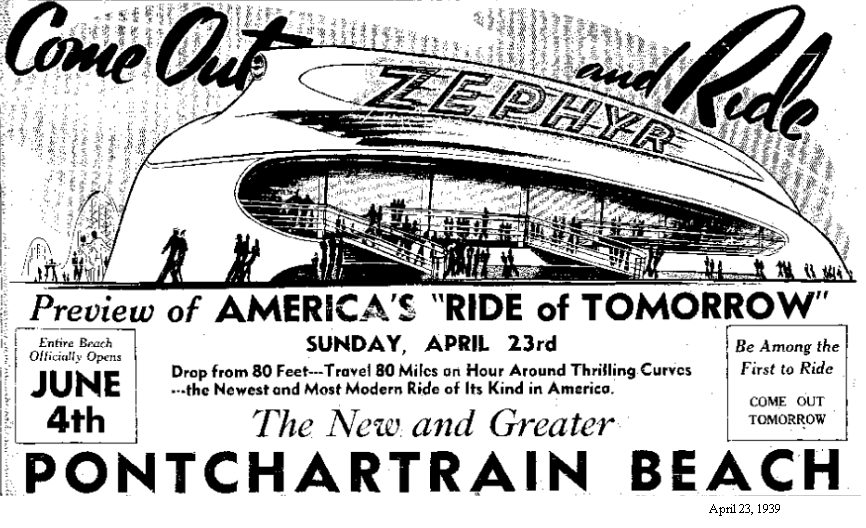|
Today in New Orleans History |
|
|
June 8


 Born
born into a socially prominent family (descendants of Jefferson Davis) in Hattiesburg, Mississippi, Dorothy Dell Goff moved
with the family to New Orleans at age 13. As an aspiring singer, she was "discovered" by composer Wesley
Lord, and signed a radio contract. At age 15 she won the title of "Miss New Orleans" in 1930. That same year she
won the International Pageant of Pulchritude in Galveston, Texas. She and Dorothy Lambour/Lamour were close friends
during their pageant days. After working on the vaudeville circuit for 32 weeks, she moved to New York in 1931. After
seeing her perform, Florenz Ziegfeld, arranged for her to appear on Broadway in the Ziegfeld Follies, and she followed this
success with her role in the production of Tattle Tales in 1933. She moved to Hollywood in December 1933
and was signed to a contract by Paramount Pictures. Shemade her debut in Wharf Angel (1934). The film was a success and the
reviews for Dell were favorable; Paramount began to consider her as a potential star. Her most important and substantial
role followed in the Shirley Temple film Little Miss Marker. Her next film Shoot the Works led to comparisons with Mae West,
and her rendition of the ballad "With My Eyes Wide Open, I'm Dreaming"became a hit record. Paramount scheduled
her to play opposite Gary Cooper and Shirley Temple in Now and Forever in what was to have been her first major starring
role as a romantic lead. On June 8, 1934, Dell agreed to a car ride to Pasadena with 38-year-old Dr. Carl
Wagner to meet his mother, whom he wanted to show "how sweet a little movie star can be." After the meeting, they
went to an all-night party at an inn in Altadena, California. Afterward, while driving to Pasadena, the car left the highway,
hit a telephone pole, bounced off a palm tree and hit a boulder. Dell was killed instantly. Wagner, who was driving between
50 and 70 miles an hour, died six hours later in a hospital. Dorothy was 19 years old. She is interred in Metairie
Cemetery in her home town. (WIKI)  

To receive an update for each day in New Orleans
history, join our facebook page
- Today in New Orleans History
Tweet
Glendy Burke, before he became the 29th mayor of New Orleans, had a paddle steamer named for him -- a name which inspired Stephen Foster compost the song "Glendy
Burke". Burke served from June 8, 1865 until June 28, 1865.
The New Orleans City Railroad Company was chartered on June 15, 1860. By 1861, twenty-six miles of horse railroad track
had been laid. Service began on the Camp and Prytania Line on June 8, 1861. Streets of the original route
included Canal, Camp, Prytania, Toledano, Poeyfarre, and Magazine. The Prytania Streetcar began operation on as a mule-drawn
car line. It was called the "Silk Stocking" line because its route included the streets of the tony Garden
District. Various route changes and consolidations took place over the years. Railway companys experimented
with several potential substitutes for horsecars. The ammonia motor was tried on several lines, including the Prytania,
but was considered to be impractical. By the 1890s all lines were electrified -- the Prytania Streetcar Line on September
15, 1894. Uptown residents could easily ride to Canal Street in the speedy and comfortable streetcars until October 1, 1932
when the line was discontinued. The Prytania Streetcar Line was serviced almost exclusively by the "Prytanias,"
a luxurious class of electric cars just as distinctive as the elegant "Garden District" neighborhood. Fifty cars
were ordered on April 21, 1910 from the St. Louisi Car Company. The exteriors were painted yellow and orange and their
numbers ran from 355 to 404. Mahogany interiors surrounded patrons seated in St. Louis rattan seats. They looked out
of Robertson windows that slid conveniently into side panels when open. The "Prytania" cars were designed for
double-end operation and the prepayment of fares, the first of its type in New Orleans. The 800 model cars replaced the Prytanias on September 16, 1923. The Prytanias were then shifted to lighter
traffic routes. A public's changing preference for private transportation made streetcar operation unprofitable.
According to a New Orleans Public Service Inc. newspaper announcement, the Prytania Streetcar Line discontinued operations
on October 1, 1932 and the Nashville Bus Line began service over a part of the territory formerly served by the line. Prytania
Street, itself, was not included. Remaining Prytanias were scrapped that same year. The
Prytania streetcar barn was located on Prytania Street between Robert, Pitt, and Upperline. After the city acquired
the property, a 1936 ordinance dedicated it for "public purposes". The location is now a shopping center,
fronting Prytania, with a CVC pharmacy (4901 Prytania) as its anchor. Main Source: http://neworleanshistorical.org/items/show/540#.Ukfi9X9dy8A
|
|
|

To receive an update for each day in New Orleans history,
join our facebook page - Today in New
Orleans History.
Analytics |




